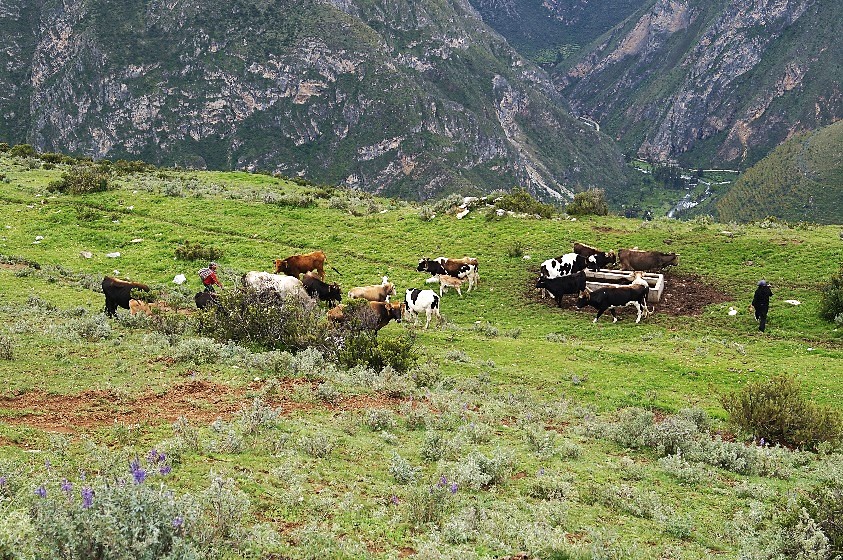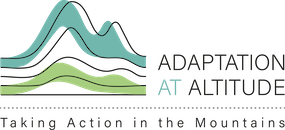Robust ecosystem-based adaptation measures in Miraflores, in the Nor Yauyos Cochas Landscape Reserve

Summary
The case corresponds to the EbA (Ecosystem-based Adaptation) experiences implemented in the community of Miraflores (other implementation sites were Canchayllo, Tanta and Tomas), in the Nor Yauyos Cochas Landscape Reserve (RPNYC), located in the central Andean zone, Peru.
Miraflores is situated in the humid Puna, with presence of grasslands, Puna grass and wetlands. The integrity of the environment is key because it provides fodder for livestock, the main economic activity in the area. The areas where robust EbA measures were implemented are those that over the last decades have had less water availability in the dry season (due to deterioration or lack of water infrastructure, changes in rainfall patterns, increased temperature, glacier retreat, etc.) and, therefore, with grassland areas with reduced grazing capacity due to the lack of water, while other areas were overgrazed. The implemented EbA measure is the sustainable management of water and native pastures through the participatory development of a Pasture and Water Management Plan in order to promote an integrated management of pasture, water and livestock resources at the communal territory, optimize the grazing system to improve the condition of pastures and strengthen community organization for better water distribution and rotation of grazing areas. Other EbA measures are the strengthening of local capacities and knowledge in management and conservation of pastures, livestock and water; and the maintenance, expansion and improvement of the ancestral water structure.
Tecnologías Ancestrales by Instituto de Montaña – Instituto de Montaña (in Spanish): (https://tmi.exposure.co/tecnologias-ancestrales)
Overview
- Location:
- Implementation sites:
-
- Single country
- Multiple locations
- Mountain region:
-
High Andes
- Province:
-
- Yauyos and Jauja, provinces
- Site locations:
-
Reserva Paisajística Nor Yauyos Cochas (RPNY)
- Solution scale:
- Area Covered:
-
- 72.54 km2
- Solution type(s):
- Sector(s):
- Climate impact(s) addressed:
- Other climate impact(s) addressed:
-
- water stress, frost
- Climate impact time-scale(s):
- Main benefit associated with the solution:
- Co-benefit(s) associated with the solution implementation:
- Implementation timeline:
-
- 2012 - 2019
- Sendai targets:
-
Solution details
Main beneficiaries & outcomes
Sixty community members from the community of Miraflores whose main activity is livestock farming (240 people, 46% women). These belong to a district with a high old-age index, where young people migrate to the city.
Planning and implementation
ACC strategies have been implemented within the framework of the “Global Mountain Ecosystem-based Adaptation (EbA) Program” (2012-2016), and consolidated with the project “Scaling Ecosystem-based Adaptation of Mountain: building evidence, replicating successes and informing policies” (2017-2019), under the responsibility of the Mountain Institute (IdM), commissioned by the International Union for Conservation of Nature (IUCN).
The EbA Mountain Project began in 2011 as a collaborative initiative of the United Nations Environment Program (UNEP), IUCN and the United Nations Development Program (UNDP). The second project was implemented between 2017 and 2019 by IdM and IUCN. Both initiatives were part of the International Climate Initiative (IKI) funded by Germany’s Federal Ministry for the Environment, Nature Conservation and Nuclear Safety (BMU).
The execution was commissioned by the Ministry of the Environment (MINAM) of Peru and was implemented in the Nor Yauyos Cochas Landscape Reserve (RPNYC for its name in Spanish), with support from the National Service of Natural Areas Protected by the State (SERNANP for its name in Spanish) and in coordination with the Headquarters of the RPNYC.
The implementation measures were constructed through a participatory process of planning, diagnosis, design and validation that included local community representatives and researchers (community members), technicians from the RPNYC-SERNANP and specialists from the institutions.
Finance
The Eba Montaña Programme was funded by the Federal Ministry of the Environment, Nature Protection and Nuclear Safety of the German Government (BMU), as part of the International Climate Initiative (IKI), in response to the agreements on UN Cancun Climate Change Conference, 2010.
Two cost-benefit analysis exercises were carried out, a traditional one and a participatory one.
Please refer to the following documents for further information (in spanish):
Innovation
The implementation of EbA measures, particularly robust measures (“no regrets”), are measures adopted by communities (and / or facilitated by organizations) that reduce vulnerability to CC or that increase adaptive capacity and that will always have a positive impact on livelihoods and ecosystems, regardless of how climate changes. The participatory process for the construction of the planning, diagnosis, design, implementation, monitoring and evaluation measures is a key aspect to achieve the success of the solution. This is based on a comprehensive design with three key inter-connected components:
1) strengthening the institutional framework and community organization for the management of pastures, water and livestock;
2) strengthening of local capacities and knowledge in the management of pastures, water and livestock; and
3) green-gray infrastructure: expansion and conservation of wetlands and community management of native grasslands.
Performance evaluation
The internal monitoring system (IdM / IUCN) is under review. Systematic measurement of the impact of robust EbA measures through indicators: 1) degree of technical knowledge in pasture management, 2) level of application of pasture management practices, 3) degree of compliance with the pasture and water management plan , 4) community initiatives for the management of pastures and water in the area of influence of the infrastructure, 5) condition of pastures in the areas of direct intervention of the measures, 6) pasture area that can be grazed in times of drought (hectares), and 7) flow measurement directed to the grazing area.
Cost-benefit analysis (CBA): conventional and qualitative.
Periodic cycles of learning in action or Action Learning.
Long term project sustainability and maintenance
Strengthening the community organization – Development of a Pasture and Water Management Plan in a participatory manner, in order to promote sustainable use of resources and improve equity in the use of pastures. This ensures the prioritization of local interests, ownership and sustainability.
Knowledge acquired – Activities to strengthen capacities and local knowledge (in community members and park rangers) in the management of pastures, grazing and water.
Improvement of green-gray infrastructure – Carried out with communal contribution for the recovery of pastures, as well as for the conduction and provision of water in grazing areas. This allows the livestock to be better distributed in the area and reduces the animal load. The ancestral infrastructure stores water providing a constant flow for population use.
These are measures based mainly on strengthening community organization, and local capacities and knowledge for the sustainable management of pastures, water and livestock.
Examples that reinforce the sustainability of the measures include financing of replications of the experience in terms of green-gray infrastructure, as well as for other projects of the Pasture and Water Management Plan. Lately, a Remuneration Mechanism for Ecosystem Services (MERESE-Hídrico in Spanish) has been implemented in the area.
Capacities for design and implementation
Knowledge
The implementation measures were constructed through a participatory process of planning, diagnosis, design and validation that included local community representatives and researchers (community members), technicians from the RPNYC-SERNANP and specialists from the institutions.
Traditional knowledge and ancestral practices of populations are key to the selection of measures, since they are the product of a long history of adaptation to changing climate conditions and the development of strategies based on human-nature interaction. The diagnosis based on the perceptions, knowledge and needs of the community is the basis for the implementation of adaptation measures. To this, scientific knowledge is added and integrated for the joint design of measures to be implemented.
The adaptation strategy includes a component for strengthening local capacities and knowledge that was aimed at community members and park rangers with the objective of providing technical knowledge, mainly for the management and conservation of natural pastures, animals and water. Agrostological evaluation workshops and training on pasture fencing, and water management and distribution were held.
Technology
One of the components of the solution is the restoration of ancestral and contemporary technologies for water management, from the fact of combination of local natural infrastructure with foreign elements such as PVC pipes or small cement works.
Political / Legal
ACC strategies have been implemented in the framework of two projects. The first was a collaborative initiative of the United Nations Environment Program (UNEP), IUCN and the United Nations Development Program (UNDP). Both projects were part of the International Climate Initiative (IKI) funded by Germany’s Federal Ministry for the Environment, Nature Conservation and Nuclear Safety (BMU).
The execution was commissioned by the Ministry of the Environment (MINAM) of Peru.
There is a National Law on ACC Framework that includes AbE.
Institutional
There is collaboration at the national government level and implementation at three scales (national, regional and local) by authorities responsible for environmental management, in alliance with local communities, organizations and research institutes.
The Landscape Reserve provides the framework to work on the three scales. At the regional level, there is a Reserve Management Committee, which establishes master management plans for the natural area protected by the State.
Participatory planning and inter-institutional articulation ensure results consistent with the needs of the communities and environmental priorities, which are the basis for ownership and governance.
Socio-cultural
Planning, diagnosis, design, implementation, monitoring and evaluation measures were carried out through a participatory process. The local communities were fully involved in each phase of the solution.
The work started from a diagnosis based on the perceptions, knowledge and needs of the communities; in addition to this, and with the integration of scientific knowledge, a joint design of robust measures was carried out, focused on the expansion and conservation of wetlands and the communal management of native grasslands. These measures contemplate the restoration of ancestral and contemporary technologies for water management in the Puna.
Outlook & Scalability
Barriers and adverse effects
None identified
Transformation and future outlook
Sustainable livestock farming can improve the economy of the RPNYC population, increasing its adaptive capacity under the future context of a changing climate. The improvement of the ancestral infrastructure and the strengthening of the institutions and the communal capacities for the communal management of water, pastures and livestock will allow an efficient use of water and pastures, buffering the effect of water scarcity.
Potential for upscaling and replication
The robust EbA measures constituted a pilot at the community level, which provided evidence of cost-effectiveness and the mechanisms to implement EbA measures for replication in the same and other communities, municipalities (at the RPNYC level) and their escalation to other natural areas protected by the State, and even to inform policies at the national level on the effectiveness of this approach.
Efforts were made on advocacy at the national and subnational levels to integrate the EbA approach (it was made effective in the regional CC strategies of Junín and Lima). The EbA Montaña project is one of the input initiatives to the national climate change planning process, now explicitly including the EbA approach (which has been implemented in the country in various ecosystems as part of various initiatives) and several adaptation measures now include this approach. The natural infrastructure measures for water security are already part of the Nationally Determined Contributions (NDCs).






Comments
There is no content